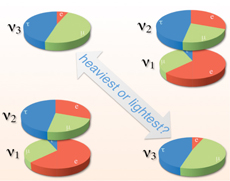Mind over matter at NOνA
 |
| Scientists know that there are three types of neutrinos but they don't know which is the heaviest. Image courtesy of NOνA
|
Neutrinos may not be faster than light, but their curious shape-shifting properties might be the reason matter exists in the universe.
“Equal parts of matter and anti-matter should have been produced in the big bang and then annihilated each other, leaving just a sea of photons,” said neutrino physicist David Schmitz, PPD. “But we exist, which means there must have been something that tipped the scale in favor of matter. Neutrinos might be the answer, and, to find out, we need to make extremely detailed measurements of the phenomenon of neutrino oscillations.”
Several experiments at Fermilab are designed to scrutinize the curious properties of neutrinos. One is the NuMI Off-Axis νe Appearance Experiment, which will use advanced detection techniques to watch for neutrino shape shifting, or oscillations.
Neutrinos exist as three different types, or flavors: electron neutrino (νe), muon neutrino (νμ) and tau neutrino (ντ). Initially, scientists suspected these neutrinos were three autonomous particles—the little brothers of the electron, muon and tau respectively. But results revealed that neutrinos oscillate between the three different flavors.
At Fermilab, the Main Injector Oscillation Search (MINOS) has been studying how muon neutrinos change into other forms since 2005. Along with other experiments elsewhere, it has found that they change primarily into tau neutrinos with a small fraction changing into electron neutrinos. The NOνA experiment will continue these measurements with much more precision.
The NOνA project was conceived ten years ago at Fermilab and has evolved into a collaboration among 152 scientists from 25 institutions. It uses the same principles as the MINOS experiment but takes the science to the next level.
“Like MINOS, NOνA uses the NuMI beam to generate neutrinos and then a near and far detector to observe their properties,” said Paul Derwent, the NOνA associate project manager. “The difference is that the NOνA experiment is more sensitive and optimized to look at the neutrinos that are most likely to undergo the muon neutrino to electron neutrino oscillation.”
One thing scientists will be looking for in particular is if the muon neutrino to electron neutrino oscillation rates are different for neutrinos and antineutrinos.
“If neutrinos and antineutrinos oscillate between flavors at different rates, it could explain why we have an excess of mass in the universe and why antimatter seems to have disappeared,” NOνA co-spokesperson Gary Feldman said. “This experiment will also help us determine the mass-ordering of neutrinos."
Neutrinos have three different mass states, in addition to the three different flavors. As a neutrino oscillates through the different flavors, the mass oscillates as well. Scientists are able to measure the flavors directly, but not the mass states. Based on the flavor measurements, scientists know that two of the mass states are relatively close together. But they do not know if the third mass state is the heaviest or the lightest of the three.
Scientists can determine the placement of the third mass state in the hierarchy based on how the electron neutrinos interact with electrons in the earth on their 500-mile journey to the NOνA far detector in Ash River, Minn. If the third mass state is the heaviest, the muon neutrino to electron neutrino oscillation will appear amplified and the anti-muon neutrino to anti-electron neutrino oscillation will appear diminished. But if the third mass state is the lightest, scientists should observe the opposite effect. This mass state may be the key to understanding why matter outweighs antimatter.
“Due to a coherent interaction between the electron neutrinos and electrons in the earth, the only practical way to measure the mass hierarchy is by observing electron neutrinos over a very long baseline,” Feldman said. “Of the near-future experiments, only NOνA has a sufficiently long baseline to measure this.”
Construction on the NOνA far detector started in 2009 and a prototype of the near detector was recently installed at Fermilab. Scientists and engineers hope to complete the upgrades to the accelerator that will generate beam by spring of 2013 and finish the rest of the detector by January of 2014.
—Sarah Charley
|